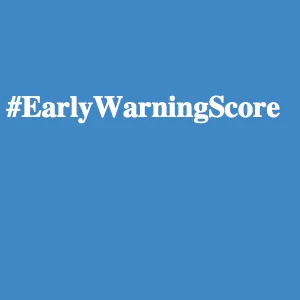Monitoring patients at risk of deterioration 3 times a day instead of twice a day did not significantly reduce the proportion of clinical deterioration in patients on a surgical or medical ward with an initial early warning score (EWS) of 0-1, according to the results of a Danish RCT published in Resuscitation (Petersen et al. 2016).
Early warning score measurement is in place in many hospitals to monitor patients at risk of deterioration and provide rapid response to prevent cardiac events or ICU admission. While evidence exists on what to measure and when to act, information is lacking on how often to monitor. John Asger Petersen, Department of Anaesthesia and Intensive Care, Bispebjerg-Frederiksberg Hospital, University of Copenhagen, and colleagues randomised patients between 8 hour monitoring and 12 monitoring, to determine if there was a difference in outcomes. The hypothesis was that a lower percentage of patients checked every 8 hours would deteriorate to a higher early warning score (EWS) 24 hours after admission than patients checked at 12 hour intervals. The study monitored two groups of patients during two six week periods. Patients were surgical and medical patients with an initial EWS of 0 or 1.
See Also: Assessing Early Warning Score Performance
8 hour checks
12 hour checks
The authors conclude: “We found no support for increased intermittent monitoring more than twice daily for patients with low EWS in our study. There is generally very low risk of clinical deterioration in this population, yet they make up the majority of hospitalised patients,ranging from 50% to 65%.This harbours the risk of using an inappropriate amount of resources on low risk patients to the detriment of intermediate or high risk patients in healthcare systems with increasing staffing challenges.”
Early warning score measurement is in place in many hospitals to monitor patients at risk of deterioration and provide rapid response to prevent cardiac events or ICU admission. While evidence exists on what to measure and when to act, information is lacking on how often to monitor. John Asger Petersen, Department of Anaesthesia and Intensive Care, Bispebjerg-Frederiksberg Hospital, University of Copenhagen, and colleagues randomised patients between 8 hour monitoring and 12 monitoring, to determine if there was a difference in outcomes. The hypothesis was that a lower percentage of patients checked every 8 hours would deteriorate to a higher early warning score (EWS) 24 hours after admission than patients checked at 12 hour intervals. The study monitored two groups of patients during two six week periods. Patients were surgical and medical patients with an initial EWS of 0 or 1.
See Also: Assessing Early Warning Score Performance
Results
The primary outcome was if patients had deteriorated 24 hours after admission with an EWS of ≥ 2. 1346 patients were included.8 hour checks
- 656 (49%)
- 23% had an EWS ≥ 2 at 24 hours, of which 3.4% had an EWS ≥ 5
- 30-day mortality 1.1%
12 hour checks
- 690 (51%)
- 20% had an EWS ≥ 2 at 24 hours, of which 2.2% had an EWS ≥ 5
- 30-day mortality 1.8%
The authors conclude: “We found no support for increased intermittent monitoring more than twice daily for patients with low EWS in our study. There is generally very low risk of clinical deterioration in this population, yet they make up the majority of hospitalised patients,ranging from 50% to 65%.This harbours the risk of using an inappropriate amount of resources on low risk patients to the detriment of intermediate or high risk patients in healthcare systems with increasing staffing challenges.”
Reduced In-Hospital Cardiac Arrests - Japan Study
A study in Japan (Nishijima et al. 2016), published in the Journal of Intensive Care, looked at the effect of a modified early warning score (MEWS) system on occurrence of in-hospital cardiac arrests (IHCA). Patients were monitored one or more times a day depending on how sick they were. Patients with an EWS of 7 or more were attended by an ICU team. The rate of IHCAs per 1000 admissions decreased from 5.21 (79/15,170) to 2.39.References:
Nishijima I, Oyadomari S, Maedomari S et al. (2016) Use of a modified early warning score system to reduce the rate of in-hospital cardiac arrest. J Intensive Care, 4: 12. doi: 10.1186/s40560-016-0134-7.
eCollection 2016.
Petersen JA, Antonsen K, Rasmussen LS (2016) Frequency of early warning score assessment and clinical deterioration in hospitalized patients: A randomized trial. Resuscitation, 101:91-96. doi: 10.1016/j.resuscitation.2016.02.003. [Epub ahead of print]
Petersen JA, Antonsen K, Rasmussen LS (2016) Frequency of early warning score assessment and clinical deterioration in hospitalized patients: A randomized trial. Resuscitation, 101:91-96. doi: 10.1016/j.resuscitation.2016.02.003. [Epub ahead of print]
Latest Articles
EWS, Early Warning Score, Monitoring, Patients
Monitoring patients at risk of deterioration 3 times a day instead of twice a day did not significantly reduce the proportion of clinical deterioration in patients on a surgical or medical ward with an initial early warning score (EWS) of 0-1, according t






